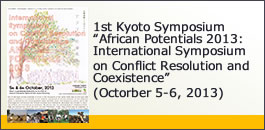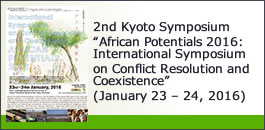[10th Plenary Committee Meeting / 3rd Public Lecture] “Peace Building in Africa: Challenges Found in the Field and the Future Options” (March 23, 2013)
Date: March 23, 2013
Venue: Inamori Foundation Memorial Bldg. (Inamori Center), Large Conference Room, Kyoto University
Program
14:00-14:15 Mitsugi Endo (Tokyo University)
Aims of the Workshop
14:15-15:15 Rumiko Seya (Japan Center for Conflict Prevention)
Peace Building in Africa: Challenges Found in the Field and the Future Options
15:15-16:00 Question and Discussion
16:30-17:30 Meeting for Exchanging Ideas between Ms, Seya and Project Members
Abstract
Many areas of contemporary Africa faces difficult questions, such as how various dispute is made to end and how dismantled and exhausted society by dispute shall be rebuilt. Rumiko Seya, who had participated in conflict resolution and peace building in Africa, talked about the problem with her experiences and the concrete example.
[9th Plenary Committee Meeting / 2nd Public Lecture] “Utilizing African Potentials for Conflict Resolution” (January 26, 2013)
Date: January 26, 2013
Venue: Inamori Foundation Memorial Bldg. (Inamori Center), Large Conference Room, Kyoto University
Program
15:00~15:15 Itaru Ohta (Kyoto University)
Aims of the Workshop
15:15~16:15 Jin Matsumoto (Journalist, Adviser to Asahi Simbun)
Does Africa Have Conflict Resolving Ability?
16:15~16:35 Break
16:35~17:35 Yntiso D. Gebre (Addis Ababa University)
Legal Pluralism and Customary Courts in Ethiopia
17:35~18:00 General Discussion
Abstract
Itaru Ohta (Kyoto University)
The Aims of the Workshop
Contemporary African Societies face the task of how to prevent conflict and violence, how to reconstruct and rejuvenate the social order destroyed and exhausted by conflicts and how citizens can reconcile after the conflict. In this conference, we discuss how the knowledge or institution, which people in Africa created, accumulated, and practiced, can be applied to those pragmatic issues.
Jin Matsumoto (Journalist, Adviser to Asahi Simbun)
Does Africa Have Conflict Resolving Ability?
□ The answer is “Yes, she does.”
□ E.g. Somaliland (population of 2.8million)
- The civil war broke out in the middle of 1980s. Barre regime collapsed in 1991.
- Armed conflicts with in Somaliland continued. There were about 20 clans and 50 thousands AK-47 .
- Clan leaders in Borama called a peace conference.
- 82 elders called out to give up guns. Militias were absorbed into police and army.
- UNDP took charge of disarmament.
- Almost all guns held by citizens were withdrawn by year 2002.
- Markets full of female. Reliable public peace.
- Though, Somaliland is “mono-ethnic country”: citizens shares common interests.
□ Multiethnic countries are put in much serious situations: Republic Democratic of Cong, Northern Uganda, Chad, Zimbabwe
- Economic collapse – food shortage – dependence on one’s own ethnicity – ethnic conflicts prevail.
- Patrons receive bribe to support clients – to the clash of national economy.
□ Is it possible to resolve conflict in multiethnic society? – “Yes, if they find other values other than depending on ethnicity”
- No prominent ethnic conflicts in the era of independence wars in Africa.
- A society that people can live without depending on ethnicity. A society that people can live by working hard will replace ethnicity-prevailing societies.
□ Do not expect governments because they are always “benefit inducing”
- Needs of incentive based on “when you work you can eat,” “when you work hard, there are more fortune.”
- Much incentive in ORAP in Zimbabwe.
- South Africa’s investment in Mozambique and Tanzania. Improvement in employment rates and labor quality.
- My experiment. Introducing economic rationality by private bodies. OSR.
□ Difficult but worth trying.
Yntiso D. Gebre (Addis Ababa University)
Legal Pluralism and Customary Courts in Ethiopia
In Ethiopia, plural legal systems exist: the formal (regular) court and the informal (customary) court. With the exception of family matters that may be handled outside of the regular court and disputes between Muslims that may be taken to the Sharia court, conflicts resolved through other traditional mechanisms lack legal recognition. However, research reveals that most people in rural communities and many people in urban areas prefer the customary courts over the formal law for all forms of disputes.
In the past, the customary dispute resolutions mechanisms were considered backward practices that need to be replaced by the modern codified law. Today, there exists a growing recognition of the relevance of traditional conflict resolutions. In recent years, it became evident that sometimes government authorities encourage customary courts to address conflicts that could not be resolved through the state machinery.
Customary dispute resolution institutions are not without blemishes, however. Some are criticized for violating human rights and for excluding women and the youth from participation in hearings. This places traditional courts at odds with the international instruments that Ethiopia has signed. There are also instances, in some localities, where customary courts handle hard crimes such as homicide and even pass death sentences at the village court level. This is another source of confrontation between the formal and informal systems.
In this presentation, I will explain the reasons why the traditional courts remain relevant and in some cases even dominant; the manifestations of the recent seemingly favorable trend and its implications; and the challenges associated with the use of customary courts.
[8th Plenary Committee Meeting / 3rd Meeting of East Africa Research Cluster] “Tanzania, a Country without Conflicts: Factors and Prospects” (November 17, 2012)
Date: Nov. 17, 2012
Venue: Kyoto University Yoshida Main Campus, Research Bldg. No.2, 4th floor, Large Conference Room.
Program
10:00〜10:30 Business Meeting
10:30〜11:20 Toshimichi Nemoto(Company Executive, JATA Tours)
Mixed Settlement of Multiethnic Groups and Conflict Prevention Urban Areas
11:20~12:10 Juichi Itani (Kyoto University)
Conflicts and Resolution Measures in Rural Areas
12:10~13:00 Lunch Break
13:00~13:40 Hiroshi Nakagawa (Former Ambassador to Tanzania / Former Director-General Food Safety and Consumer Affairs Bureau, Ministry of Agriculture, Forestry and Fisheries, Japan)
Various Anxieties for Stability: Economic Growth and Retreat of Nyerere’s Dream
13:40~14:30 General Discussion
Chaired by Minako Araki (Ochanomizu University)
Abstract
After gaining independence from Britain in 1961, Tanganyika merged the People’s Republic of Zanzibar and established the United Republic of Tanzania (hereinafter Tanzania) in 1964. Julius Nyerere, who became the first president of Tanzania, advocated African Socialism based on family-like ties, or “familyhood”, in the Arusha Declaration in 1967. While creating administrative villages called ujamaa as the units, the Declaration had self-reliance and resource sharing as the centers of the policy, and included unique policies such as collective settlement, collective farms and thorough elementary education in Swahili language in order to achieve a peaceable and equal society. However, the national economy was ravaged by frequent droughts, the oil shock and civil war in Uganda in the 1970s, when the Ujamaa village policies were implemented, and consequently the policy increasingly lost its impetus. Nyerere stepped down in 1985, and the country turned its policy toward capitalist economy by acceptance of the Structural Adjustment Program in 1986.
African countries achieved independence following the “Year of Africa” one after another, and worked on self-sufficient nation building. However, the roads to food self-sufficiency and economic independence were rough with repeating political changes or ethnic conflicts caused by poverty and political instability. Thus, Tanzania found herself as the receiving country of refugees from neighboring countries. Tanzania has also gone through changes in policies and economic structures since formation of the United Republic until today. Its process involved forced resettlement and severe economic hardships, consequently leading to larger discrepancy between the reality and self-sufficient nationhood that Nyerere had idealized. However, in Tanzania, there has been no large-scale coup d’état or inter-ethnic conflict for the last half century in contrast to internal conflicts in its neighboring countries. Of course we cannot overlook armed clashes occurring between ruling and opposition parties at every general election in Zanzibar. Yet none of them have been intensified or prolonged, nor led to mass-scale religious/ethnic conflicts.
African countries started rapid economic growth in the mid-2000s after the era of economic stagnation. Its driving force was underground resources. The soaring price on crude oil and minerals on a global scale as well as the resource development race among foreign capitals resulted in flooding Africa with funds. Although one of the factors supporting economic development in Tanzania is gold mines, the industry has not benefited all of the people. In fact, price rise and city-oriented policies have strained the rural economy and even led to widening economic disparities.
With a focus on the fact that large-scale conflicts have not occurred in Tanzania for the last half century, this workshop explores the mechanism to avert conflicts in systems, disciplines, customs and policies by examining the factors from urban, rural and political perspectives. There exist local disciplines to recede daily disputes in rural communities, and we can also see unspoken rules to maintain orders among urban communities inhabited by mixed ethnic groups. Such mechanisms of maintaining orders are reflected in political bodies and policies. Assuming that there is a common concept in both macro- and micro- societies in Tanzania, what is it and how has it been developed in the history? Moreover, we will attempt to consider whether such a concept would continue its effective function even in an increasingly complicated, modern society.
Toshimichi Nemoto(Company Executive, JATA Tours)
Mixed Settlement of Multiethnic Groups and Conflict Prevention in Urban Areas
I describe how people have averted disputes and have collaborated through examining case studies, while giving an overview on the history of national formation in Tanzania. Religious, ethnic and educational systems.
Juichi Itani (Kyoto University)
Conflicts and Resolution Measures in Rural Area
Although social orders are maintained by laws and ordinances in Tanzania, rural societies have problems unsolvable by contemporary law, and they have solved such issues by their customary approaches. I will take up several issues of Tanzanian rural conflict communities, make reports on farmers’ handling of them, and consider the averting mechanisms seen in rural communities.
Hiroshi Nakagawa (Former Ambassador to Tanzania /
Former Director-General of Food Safety and Consumer Affairs Bureau, Ministry of Agriculture, Forestry and Fisheries, Japan)
Various Anxieties for Stability: Economic Growth and Retreat of Nyerere’s Dream
A “society where people are equally poor” remains stable at a low level without mounting complaints. However, from 2003 onward the global escalation of underground resource prices has brought a rapid growth in the Tanzanian economy, and has burst economic disparities to be apparent. The equal society that Nyerere dreamed about has gradually fallen back in a stream toward the economy-oriented society. I will consider whether “systems or frameworks that obviated conflicts” in Tanzania will be maintained to solve unstable factors even in globalizing conditions providing an outlook of the country’s future trends in governance.
[7th Plenary Committee Meeting] “Conference on Future Research Plan” (July 14, 2012)
Date: Jul. 14, 2012
Venue: Inamori Foundation Memorial Bldg. (Inamori Center), Middle-sized Meeting Room (Room No. 332), Kyoto University
Memorandum
For this general meeting, facilitators and assistant managers of each unit and cluster gathered and discussed the following topics regarding the future research plan:
- Possible methods to disperse the main project’s results internationally and domestically.
- 5th European Conference on African Studies: African dynamics in a multi-polar world (June 2013, Lisbon, Portugal: Panel Proposal Deadline on Oct. 19, 2012)
- 55th Annual Meeting of African Studies Association: Research Frontiers in the Study of Africa (November 2012, Philadelphia, USA: Panel Proposal Deadline on March 2013)
- Canadian Association of African Studies Annual Conference 2013 (May 2013)
- Regional Conference of International Geographical Union 2013: Traditional Wisdom and Modern Knowledge for the Earth’s Future (August 2013: Joint session with related academic society [20 min presentation x 4]. Panel proposal deadline on the end of Aug. 2012)
- Annual meeting of American Anthropological Association (November 2013)
- Inter-Congress of International Union of Anthropological and Ethnological Sciences (May, 2014)
- Annual Conference of Japan Association for African Studies (May 2013 at University of Tokyo)
- The possibility of utilizing academic journals and special reports to announce project results.
- Where and when to hold the international symposium in Japan scheduled for FY 2013.
- Possible locations for the “Africa Forum’’ in FY 2013.
- The best method of accumulating data in the ‘’Data Archive.’’
[6th Plenary Committee Meeting] “From Large scale conflicts to small scale ‘everyday’ conflicts: Introduction of Residents Participation and Changes in Natural Conservation Strategy” (May 12, 2012)
Date: May 12, 2012
Venue: Inamori Foundation Memorial Bldg. (Inamori Center), Middle-sized Meeting Room (Room No. 332), Kyoto University
Program
10:00~10:15 Business Meeting
10:15~10:30 Gen Yamakoshi (Kyoto University)
The aim of the meeting
10:30~11:30 Nobuyuki Sekino (Kyoto University)
The Conflict Amplifying Residents Participatory Resource Management: a case from Senegal
11:30~12:30 Ayumi Onumu (Keio University)
Profit Distribution and Its Patterns in the Context of Natural Resource Conservation Incentive
12:30~13:15 Break
13:15~14:15 Keiichi Omura (Osaka Universy)
Toward ‘Nature = Social Diversity’: Choice of Inuit who defies the global network
14:15~14:45 General Discussion
Report
Gen Yamakoshi (Kyoto University): Introduction
First, an introduction was given on the following topics: recent trends in environmental protection in Africa, diversification of state-driven conservation policy, and implementation of economic principles. Then, the importance of investigating the political nature and power in natural resource conservation in Africa and the impact on the local residents and their coping strategy followed were reported. Also it was reported that the recent study has a characteristic of analyzing environmental policy together with micro approach of analyzing local residents’ strategy.
Nobuyuki Sekino (Kyoto University)
The Conflict Amplifying Residents Participatory Resource Management: a case from Senegal
After an introduction of the history of Senegal’s fishing industry and the establishment of marine sanctuaries, objectives of joint management of B Community Marine Sanctuary by the government and regional community cooperatives, and achieving both biodiversity conservation and regional development were explained. The presenter reported there are several problems. There is friction of opinion over the way of non-fishing area establishment in the marine sanctuary. The eco-lodges, which were built in the marine sanctuary, do not lead to the employment of the local residents. There are also dishonest administration, rampant conflict regarding profit distribution, project’s financial viability and financial opacity of the management committee. Environmental NGOs participate heavily in politics (e.g., electing local assembly members) and are expanding afforestation projects through the collaboration with the mass media and industry. The mangrove afforestation projects, which attempted to cope with climate change, seemed succeeded by planting 36.7 million trees since 2009 by funds from a French enterprise. The project itself is, in fact, considered to be a failure. As a result, the NGOs have split apart and are now competing with one another. The observed increase in population of the thiof (a subspecies of grouper that is representative of the mangrove biosphere) because of the establishment of the marine sanctuary can also be interpreted as a success; however, there are also mixed opinions. By running the project with friends, people becoming suspicious for nepotism and unfair bias. Due to the establishment of cooperative marine sanctuary zones, global and national relationships have given rise to and amplifying local conflicts. The attitude of finding the solution through repeating trial and error at the site is now required.
Ayumi Onumu (Keio University)
Profit Distribution and Its Patterns in the Context of Natural Resource Conservation Incentive
It is important for the local constituency to become the main driving force in community based management. CBM can be divided into four main categories on the basis of usage of the market (commercial and non-commercial) and presence of extraction (extracting and non-extracting). In terms of strength of benefits, commercial > non-commercial, and extracting > non-extracting. Therefore, the monetary incentive is high and can be created through strategic delivery of supply. However, the unpredictable nature of the market leads to severe fluctuations in demand, which consequently impacts the stability of benefit. If the cost of monitoring is less and the reward is also small in the condition of fixed reward, then the conservation project likely to fail. However, when the increase in revenue outweighs the monitoring cost, the locals’ participation level may increases. In the case of the income from CAMPFIRE safari hunting in Zimbabwe, the majority of revenue came from hunting, with 60% coming from elephants. The locals allocated funds for the maintenance of lifestyle infrastructure by returning 50% of the revenue to the region. The quality of community governance is crucial for CBM success. Ethics and morals become a part of the redistribution of cash income, making the issue rather complicated. It was shown that when payment is correlated with contribution, production output is maximized.
Keiichi Omura (Osaka University)
Toward ‘Nature = Social Diversity’: Choice of Inuit who defies the global network
Omura first looked back on the history of aboriginal movement among the Inuit people in the Arctic tundra. Achieving internal results in a modern state through active participation in aboriginal movements may possibly lead to the promotion of assimilation of aboriginal people to the mainstream society (i.e. ‘’white society’’). However, while the Inuit people have partially become integrated into the global network, they have not been completely assimilated and have succeeded in keeping their Inuit identity intact. This is because, through the process of this movement, they have managed to preserve the “Inuit lifestyle” which differs from the global standard through an occupational system based on the interaction of humans and animals, along with a diversity of nature—culture that is based on humans and non-humans alike. Finally, as a suggestion for the ideal Inuit form of governance, Omura puts forward the structural framework of democracy extended to objects; in other words, the establishment of a “mono-Congress” in addition to “modern democracy.”
(Shuichi Oyama, Toru Sagawa)
[5th Plenary Committee Meeting] “A Summary of Activities in FY 2011 and Further Proposals for the Fiscal Year 2012” (March 29, 2012)
Date: March 29, 2012
Venue: Inamori Foundation Memorial Bldg. (Inamori Center), Middle-sized Meeting Room (Room No. 332), Kyoto University
Program
10:00-10:30 Business Meeting
10:30-12:30 Motoji Matsuda (Kyoto University) / Eisei Kurimoto (Osaka University)
Report of“The 1st International Forum: Conflict Resolution and Coexistence through Reassessment and Utilization of “African Potentials”” in Nairobi and Summary of the Discussion
13:10-14:10:
Shinichi Takeuchi (JICA Research Institute)
Report on the Activity of Research Unit on Politics and International Relations
Motoki Takahashi (Kobe University)
Report on the Activity of Research Unit on Economy and Development
Gen Yamakoshi (Kyoto University)
Report on the Activity of Research Unit on Livelihood and Environment
Motoji Matsuda (Kyoto University)
Report on the Activity of Research Unit on Culture and Society
14:10-14:30
Itaru Ohta (Kyoto University)
Further Proposals for the Fiscal Year 2012
Report Overview
1. Motoji Matsuda and Eisei Kurimoto reported on the proceedings and results of the Forum on African Conflicts and Coexistence, held 2-4 Dec. 2011 in Nairobi, Kenya:
First and foremost, this forum was significant in that it confirmed the idea that, “Conflicts are to be resolved through the utilization of the African potentials.” This idea was unanimously recognized and reestablished as the starting point to all conflict resolution among the participating African researchers and activists.
Second, the forum devoted much discussion on how to tackle the difficulties inhibiting the practical application of the African potentials. The African participants evaluated the forum highly, as it elucidated the major issues on conflict and coexistence. The feedback to the organizers was that the issues brought to fore in this forum should be revisited in the ensuing forums of the following fiscal years, as well as that some core participants should be reinvited to the forums and remain in the overall project to ensure meaningful continuity in the research.
2. Each [organizer /overseer /facilitator] of the 4 units (the Politics and International Relations Unit, the Economy and Development Unit, the Livelihood and Environment Unit, and the Culture and Society Unit) announced their progress report. (Shinichi Takeuchi substituted for Mitsugi Endo who was unable to attend.) The Project Leader, Itaru Ota, made further proposals for the fiscal year 2012 to each unit on the major issues to be emphasized. (Reporter: Toru Sagawa.)
[4th Plenary Committee Meeting] “Land, Resource, and Conflict in Africa” (January 28, 2012)
Date: January 28, 2012
Venue: Inamori Foundation Memorial Bldg. (Inamori Center), Middle-sized Meeting Room (Room No. 332), Kyoto University
Program
10:15-11:15 Motoki Takahashi/ Hiroki Ohta (Kobe University)
Politics of Property Right: Land Problems, Development and Conflict in Africa
11:15-12:15 Jun Ikeno (Kyoto University)
Policy Changes, Urban Development, and Local Public Goods: Incendiary Factors Concerning “Commons” in Northern Tanzania’s Mwanga Region
12:45-13:45 Shuichi Oyama (Kyoto University)
Conflict Over Land between Farmers and Pastoralists in the Sahel: Rebuilding of Coexistence Relationship Utilizing Local Potential
13:45-14:30
Discussion
Report Overview
Three presentations (one was a joint presentation) were conducted during the 4th general meeting on the current issue of conflict and coexistence over land in various regions across the African continent.
Motoki Takahashi/ Hiroki Ohta (Kobe University)
Politics of Property Right: Land Problems, Development and Conflict in Africa
Africa’s economy is continuing to grow since the beginning of the 21st century, but it is currently in a transitional period. The first presenter, Motoki Takahashi (joint presentation with Hiroki Ohta) stated that the important point to clarify is the direction of this transition. Population increase must be a major focus because the African population is expected to increase 2.5 times from 2010 to 2060. This indicates a societal shift from land abundance to land scarcity in Africa. Resource scarcity has caused a discrepancy where existing policies are unable to cope, and policy adjustments are required to address the exposed differences. The current implementation of individual land possession rights in Kenya, where Takahashi has conducted field research, has led to the exclusion of certain groups and thus caused a scarcity of land for these groups. This may lead to political opposition and conflicts. The construction and implementation of land policy is often also connected to the politicians’ greed. Takahashi stated that it is important to incorporate the indigenous knowledge of coexistence in the creation of African policies, particularly in the new property rights maintenance policy that is presently being developed.
Jun Ikeno (Kyoto University)
Policy Changes, Urban Development, and Local Public Goods: Incendiary Factors Concerning “Commons” in Northern Tanzania’s Mwanga Region
Jun Ikeno, the second presenter, offered several provocative issues and points of conflict related to “local commons” in the Mwanga region of Tanzania, which require adjustments and mediation. For example, the town of Mwanga is experiencing the removal of trees and gravel from the riverbed owing to a heightened demand for construction materials related to economic development and a subsequent increase in new construction. Degradation of the environment is becoming a problem because this land has no clear ownership. The public water utility has installed water meters in surrounding villages because water facilities were needed to accommodate the population increase. However, villagers living near Mwanga town had created and maintained their own water facilities prior to town development and have refused payment to the utility company. In addition, sales of land around the town have increased, and an influx of new residents to this land has led to new problems. Ikeno has stated that although these problems have not yet led to armed conflicts, it is important to consider the roles of various actors in the conflict by defining the incendiary factors prevalent in the local society. He closed the presentation by adding that instead of presuming the local population to always be “right,” researchers must consider whether the proposed changes will cause problems in the future.
Shuichi Oyama (Kyoto University)
Conflict Over Land between Farmers and Pastoralists in the Sahel: Rebuilding of Coexistence Relationship Utilizing Local Potential
Shuichi Oyama, the third presenter, explained the background and current situation surrounding conflicts between pastoralists and farmers of the Sahel region of Niger. In the past, farmers (primarily the Hausa) and pastoralists (primarily the Fulbe) created a mutual economic exchange system of bartering agricultural and pastoral products. However, grazing land was turned into Hausa farmland and the land for pastoralists was reduced considerably. As a result, livestock cause heavy damage to agricultural products, particularly during the rainy season, which is also harvest time. Although negotiations continue on monetary settlements for crop damage, contradictions sometimes appear between the statements made by farmers and pastoralists regarding the actual damage. These contradictions lead to conflicts, even to the point of homicide when agreements are not reached. Furthermore, a gap exists between the wealthy and the poor in the farmer population, and the poor farmers vent their frustration on the wealthy in the form of violence against the pastoralists. On the other hand, some initiatives are underway to foster new coexistence relationships and alleviate conflicts. In the case of a crop being damaged, a designated pastoralist would mediate, thus avoiding further deterioration of relationships. Oyama is personally attempting to implement the alleviation of conflict using the traditional expertise of the Hausa. Specifically, one area is promoting afforestation by using city waste. This restored green land is then utilized for raising livestock thus creating a space that can be used in “kowa” (unity). (Reporter: Toru Sagawa)
[3rd Plenary Committee Meeting] “Activities of Truth and Reconciliation Commission (TRC) and Reconciliation among Peoples in South Africa” (November 26, 2011)
Date: November 26, 2011
Venue: Gakuyu Kaikan, Meeting Room, Kyoto University
Program
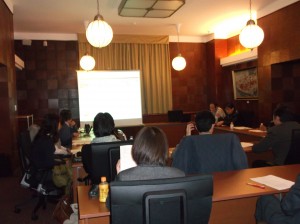
10:15-11:15 Toshihiro Abe (Otani University)
South Africa’s Truth and Reconciliation Commission (TRC) and Its Aftermath
11:15-12:15 Yoichi Mine (Doshisha University)
The Mystery of Justice and Spheres of Intimacy—A Record of the South African TRC by a ‘Conscientious Afrikaner’
12:40-13:20 Meyu Yamamoto (Kyoto University)
Reconciliation and Amnesty in the TRC
13:20-14:30
Discussion
Report Overview
Toshihiro Abe (Otani University)
South Africa’s Truth and Reconciliation Commission (TRC) and Its Aftermath
Toshihiro Abe presented an assessment and analysis of the South African TRC’s activities and characteristics. The Commission’s activities had a legal foundation in the 1995 TRC Law. However, they lacked any legal definitions of “truth” and “reconciliation.” To assure the legitimacy of its activities, the commission was careful to conduct investigations in public hearings and keep records. Grants of amnesty were one of the Commission’s frequently highlighted activities. However, these grants were not rooted in such a spirit as “post-apartheid mutual forgiveness.” Two prerequisites existed for a grant of amnesty: the offense in question was “political violence” and the testimony brought forth was “full and complete testimony.” Furthermore, the actual amnesty hearings were notably different from normal judicial proceedings, and the interaction between the commission members and those gathered at the hearings sometimes led to instances in which offenders changed their previous attitude of denying and started apologizing. These cases were publicized to a wide audience by the mass media, such as TV.
Abe noted that a 2011 survey of public opinion highlighted negative responses to the question of whether the TRC served to improve race and ethnic-group relations. Criticism was also leveled inside and outside South Africa, claiming, for example, that the “TRC did not sufficiently call out the apartheid government officials,” “TRC should have the authority to investigate corruption during apartheid,” and “fundamental direction and principles of the TRC are biased.” While emphasizing the variety of viewpoints on how to assess and situate the TRC, Abe argued that rather than functioning to resolve and “eliminate enmity between racial groups,” the TRC was likely a medium for “transitioning from armed conflict to (non-violent) negotiation, transaction, and competition” in South African society. (Reporter: Toru Sagawa)
Yoichi Mine (Doshisha University)
The Mystery of Justice and Spheres of Intimacy—A Record of the South African TRC by a ‘Conscientious Afrikaner’
Having penned a commentary in the Japanese translation of the book Country of My Skull (Gendai Kikakushitsu, 2010), Mine’s discussed the TRC-inspired book and its author. The strong international focus on the TRC was caused by the following characteristic features of the TRC among other things: Its scale and detailed testimonial records, its introduction of a full-fledged amnesty system, the manner of examining the historical relationship between Africa and the West in regard to assigning blame for racism. Moreover, the TRC with such characteristics was set in South African history of suffering much wanton death. The book was written by a South African journalist who issued reports directly from the TRC proceedings. The book does not simply present the relations between victims and perpetrators during apartheid as blacks against whites but maintains the complexity of the relationships as they really were, as in the cases of whites who were killed while participating in the liberation movement, and blacks who became police spies.
The author, Antjie Krog, is an Afrikaner—a descendant of the first white (mostly Dutch) immigrants who settled in what is now South Africa in the mid-17th century. During the apartheid era, whites were able to live normal lives in South Africa, with the majority basically oblivious to the large-scale, institutional discrimination and human rights violations that were taking place against blacks. As a journalist in charge of reporting the outrageous violence that came to light through the TRC, Krog had to constantly face the fact of her complicity as one of the oppressors and reflect on it as she carried out her work. Krog also writes critically about how the TRC became politicized by the National Party, the ANC, and others. At the same time, having covered the entire process of the TRC, Krog brings her book to a close by looking forward to the possibility of the creation of a community of new South Africans who uphold the honor of their affiliated group while also acknowledging their sins and responsibilities, or in other words, a “fusion of dignity and redemption of a higher dimension.” (Reporter: Toru Sagawa)
Meyu Yamamoto (Kyoto University)
Reconciliation and Amnesty in the TRC
In the context of a review of the amnesty approval process of the Truth and Reconciliation Commission (TRC), Yamamoto clarified the difficult circumstances surrounding the authorizing of “justice” and people’s opposition to revisiting the past violence. The Amnesty Committee served to approve amnesty for actions, inactions, and violations under apartheid and in connection with political ends during 1960–1994. The approval for amnesty was conditional upon an individual’s confession of past transgressions. The total number of amnesty petitions submitted was 7,115, and 1,167 of them were approved. The majority of the petitions came from individuals already imprisoned, and the number submitted by apartheid government officials and military leaders was small. Former administration officials criticized the amnesty grants owing to the uniform reprieve given to ANC members. On the other hand, the criticism offered by ANC intellectuals concerned whether or not violence committed as an act of resistance should be pardoned. Yamamoto also explained the various views on the pros and cons of distinguishing between anti- and pro-apartheid strife, how Mandela’s speeches lent efficacy to the TRC, and how the ANC intelligence agency filed for amnesty, thus quieting the internal voices of criticism. Moreover, Yamamoto spoke about whether it is possible ethically to distinguish violence under apartheid and whether violence in the form of resistance is a crime. She then summarized the issues surrounding the TRC, noting the difficulty of authorizing “justice” in modern conflicts. (Reporter: Shuichi Oyama)
Discussion
During the discussion time, first, two perspectives emerged on the issue related to the systems and the workings that concluded the TRC. One view was that the TRC activities were certainly a significant opportunity to transform the manner in which South African history and society were approached; however, it was inappropriate to see those activities as an end point to conflict resolution and reconciliation. The TRC recognized “multiple truths” in addition to “legal truth,” allowing testimony and official records of various opinions and interpretations regarding apartheid that would have been impermissible under normal law. However, many voices existed that were not heard during the TRC proceedings and attempts were made afterward to hear such voices outside the proceedings.
Another perspective was that the issue of the effectiveness of conflict resolution in South Africa should not be reduced to an explanation of the institutional problems of the TRC. The reason for this is that conflict resolution is determined by the manner in which the conflict started and developed, whether it ended, and what entities assumed political power afterward. The possibility for transitional justice is entirely dependent upon the path that the society in question took up to that point. Thus, when considering the “leveraging” of African Potentials, it is possible that the degree to which any leveraging can occur in conflict resolution rests on reflection, in each individual case, on the state of the conflict that arose and the systems that followed in the particular country or region.
Concerning African Potentials, it was mentioned that Abe’s point, that “The TRC was more likely a medium for ‘transitioning from armed conflict to (non-violent) negotiation, transaction, and competition’ in South African society,” might also very well apply in this case. “Negotiation, transaction, and competition,” for example, are similar to the ritual processes observed across Africa. That is, the “unification of communities by implementing ritual” presumed by functionalistic analysis actually very rarely proceeds in a unidirectional fashion, and the ritual often fails. However, this failure does not mean that the people see the ritual as fundamentally flawed. Rather, by continually repeating the ritual and re-negotiating each time, a “provisional truth” is worked out that allows the participants to address the state of affairs. It was argued that such negotiation leaves open an avenue for handling situations and can sow seeds of hope.
Meanwhile, even if the TRC was more likely a medium for “transitioning from armed conflict to (non-violent) negotiation, transaction, and competition,” the following questions were raised: Was the TRC indeed became a forum for facing the concerns of those who lost their lives while participating in the anti-apartheid conflict? Did the TRC rebuild South Africa in a manner that would lead to restoring a type of balance that could bring security to the lives of surviving relatives? Which parties were able to participate in the TRC as equal players, and which were not? What level of power had to be wielded to secure a place as an equal player in the first place? In addition, it was noted that two and a half years was an unreasonably short span of time for the TRC to judge historical prejudice that had been ongoing since the middle of the 17th century. It would not be surprising, then, if the commission continued till this day.
Finally, overlapping with the discussion from the 2nd research meeting on the post-election violence in Kenya’s last election, when considering options for Africa’s conflict resolution overall, participants exchanged opinions in which they envisioned a division of labor of sorts that would enlist “legal judgment” via domestic courts, the ICC, etc. for treating large-scale human rights violations such as apartheid, while leveraging African Potentials for conflicts that arise in a more local context. (Reporter: Toru Sagawa)
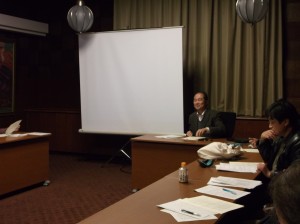
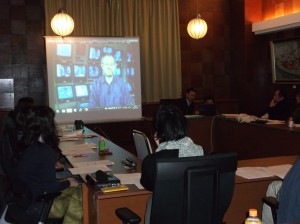
[2nd Plenary Committee Meeting] “Post-Election Violence (PEV) in 2007-2008 and its Reconciliation Process in Kenya” (September 23, 2011)
Date: September 23, 2011
Venue: Inamori Foundation Memorial Bldg. (Inamori Center), Middle-sized Meeting Room (Room No. 332), Kyoto University
Program
11:00-12:00 Miwa Tsuda (Institute of Developing Economies)
From Mediation to International Criminal Court: Coping with PEV in Kenya
12:00-12:30 Motoji Matsuda (Kyoto University)
Tasks and Problems of the Truth, Justice and Reconciliation Commission in Kenya
12:30-13:00 Naoki Naito (National Museum of Ethnology)
Confrontation of Local Groups Caused by General Election and its Local Solutions: A Case of the Pastoral Ariaal in Northern Kenya
13:00-14:30
Discussion
Report Overview
Three speakers presented talks that focused on the Post-Election Violence (PEV) in Kenya from 2007 to 2008 and the subsequent conflict-resolution processes.
Miwa Tsuda (Institute of Developing Economies)
From Mediation to International Criminal Court: Coping with PEV in Kenya
Miwa Tsuda first addressed the damage caused by the hostilities and the circumstances that led to the eruption of PEV. She then spoke about the setbacks in the post-conflict reconciliation process in Kenya that ended with the involvement of the International Criminal Court (ICC). The Waki Commission’s October 2008 report had advised for a special tribunal for the PEV within the nation; however, a lack of majority support in the parliament resulted in failure to establish the tribunal. A year later, in October 2009, President Kibaki and Prime Minister Odinga announced their intentions to entrust the ICC with the prosecution of the PEV perpetrators named by the Waki Commission. In December 2010, the ICC opened two cases of “crimes against humanity” during the PEV, naming six individuals implicated in the cases. In March 2011, summonses were issued for these people. Currently, the first phase of judicial proceedings is being held in the Pre-Trial Chamber of the ICC, and it is being debated whether sufficient evidence exists for each criminal charge against the accused. During the inquiry, it has been argued that Kenyan support for the ICC comes mainly from the urban intellectual class, while the majority of Kenyans see the six subpoenaed individuals as “martyrs, sacrificed to Western European colonial power.”
Motoji Matsuda (Kyoto University)
Tasks and Problems of the Truth, Justice and Reconciliation Commission in Kenya
The following speaker, Motoji Matsuda, explained the process for establishing the Truth, Justice and Reconciliation Commission (TJRC) in Kenya, and current developments surrounding it. The commission was ratified in April 2008 and began its activities in August 2009 on the basis of the principles of “national healing and reconciliation.” However, the commission was not active. In April 2011, local hearings finally began in various regions of the country. The commission is exploring how to use the model of South Africa’s post-apartheid Truth and Reconciliation Commission’s dialogue-based reparative justice. Criticism of the commission, however, focuses on the possibility that the dialogues will be used as political tools to delay the punishment for the perpetrators named in the Waki Report. Furthermore, it has been pointed out that there is no political legitimacy for a truth commission to be established by the current president’s administration, which has held sway at the center of Kenya’s politics since independence. It has been also noted that the period of history at issue only begins from national independence in 1963, ignoring discussion of the grave human-rights violations that occurred prior to the period when Kenya was under the control of the British colonial government. During the question-and-answer session, participants discussed the average Kenyan citizen’s views about and expectations from the commission and how these expectations were strikingly low. It was also mentioned that newspaper articles on the subject are rare. Moreover, when such articles do appear, news of the ICC is printed on the political news pages, while that of the commission is relegated to general or miscellaneous columns. The question was raised as to why, in the case of not only Kenya but also other countries, Western nations frequently have high expectations for initiatives such as truth commissions, whereas the citizens of the country in question do not particularly pay much attention to them.
Naoki Naito (National Museum of Ethnology)
Confrontation of Local Groups Caused by General Election and its Local Solutions: A Case of the Pastoral Ariaal in Northern Kenya
The third presenter was Naoki Naito, who spoke about the Ariaal people of northern Kenya and how deeply hostile relations developed between them and their neighbors on the occasion of the national parliamentary elections. Naito also discussed the extent to which these hostilities receded after the elections. In 2003, the Constituency Development Fund was introduced in Kenya, allowing members of parliament to freely use part of funding distributed to their electoral districts. As a result, local interest in elections rose. Over an electoral zone, a candidate from the Ariaal society labeled the Rendille people (who up to that time had been known as kinsmen by the Ariaal) as enemies. This deepened divisions between the social groups. However, after the elections, rather than speaking about the differences that were created and intensified during the elections, people chose to conceal them in order to prevent any further deterioration of relations. Naito emphasized that this stance of “muting” themselves functioned to avoid any exacerbation of the enmity. During the question-and-answer session, the issue came up of whether irreversible changes had occurred between the daily life before the elections and the restored daily life after the heightened animosity between the social groups.
Discussion
Initially, during the overall group discussion, the talk centered on how to relate the ICC stance of calling for “punishment through impartial laws” and the “African approach” to conflict resolution when dealing with PEV in Kenya.
First, it was noted that there is domestic criticism within Kenya of the practice of “punishment through impartial laws” that was attempted by the ICC. However, the criticism is partly driven by politicians who seek the continuation of the political impunity they enjoy. The speakers noted that there is considerable danger of them being seen as aligning with such a viewpoint in the lack of careful management of their anthropological argument, which is that “rather than imposing Western norms of universal justice, avenues should be explored to address the current state of affairs by leveraging African Potentials.”
Furthermore, the participants voiced their thoughts on the debate over the assertion by international society that “the ICC should pass judgment according to the global standards of law because if matters are left to Africa, punishment will only be avoided.” The discussion brought up a host of points: (1) Matters must proceed on the basis of the fundamental principle that judgment in some form must be passed on those who transgressed. (2) The Kenyan government should take some blame for the involvement of the ICC because it was they who failed to establish the special tribunal. (3) There is a strong possibility that neglecting punishment will re-manifest a long-term trend of “skirting the blame.” However if outside agencies participate in passing judgment and punishment, then the long-term impact should also be considered, such as a backlash of nationalism in the country concerned. (4) The international law is heading toward a direction where it should not expound the form of universal justice that simply overlooks a regional context but rather continue to consider the framework of public opinion in each country that it judges. (5) Even for the ICC—the steward of “impartial law”— while decision making is being carried out by recourse to laws, extralegal factors warrant real consideration as well in the process of judging the perpetrators.
In addition, assertions were made that the people of Africa do not overreact to the mediation by the ICC and this is a typical “African” response. Further, while handling the perpetrators, all participants—the ICC, state, and local communities—rely upon basic standards that are established by the international society, mainly of the West. However, a majority of African societies generally have a more diluted approach to disciplining “criminals.” As such, the discussion noted that it may be necessary to shift the boundary between “grave violations” and problematic behaviors.
Discussion then focused (not solely in the case of Kenya but other African nations as well) on whether more general “African Potentials” can be effective in reconciling and controlling large-scale organizational violence during and after conflict. It was pointed out that, first of all, because “African Potentials” have been downplayed till now, it is necessary to start considering them as a means to address and suppress conflict. At the same time, however, there certainly are limitations to the capacity of these potentials, and therefore it is necessary to study the problems they can and cannot resolve. In connection with this issue, it was mentioned that there exist “points of no return” in tremendously escalated violence (such as in Rwanda’s 1959 social revolution hostilities) that make it extremely difficult to suppress conflicts emerging from very large-scale organized unrest. Conversely, it was also noted that before reaching such points, “African Potentials” should be leveraged so that the possibility of turning back still exists in the background. Last, it was stated that despite the continued prevalence of violence in various African societies, it is important to clarify and illuminate the characteristics of those societies that have been relatively successful at stemming conflict at an early stage. (Reporter: Toru Sagawa)
[1st Plenary Committee / 1st Public Lecture] “Conflict Resolution and Coexistence in Africa”(July 2, 2011)
Date: July 2, 2011
Venue: Inamori Foundation Memorial Hall (Inamori Center), Kyoto University
Contents
The greatest obstacles facing modern African society are the impoverishment and disintegration of the social order caused by conflict. In particular, since the 1990s, large-scale civil wars and regional strife have erupted regularly, and multifarious conflicts have been occurring, such as violent clashes over land ownership and use, as well as territorial disputes over political resources. The international society has been seeking a solution to this state of affairs according to the normative values and concepts that originated in the U.S. and Europe, such as liberal democracy.
In response to these issues, our workshop takes an entirely different stance, namely, that the knowledge and institutions created, developed, and employed by African people can also serve to achieve conflict resolution and a state of coexistence. However, such knowledge and institutions are not fixed and unchanging entities within Africa. Rather, they have grown out of Africa’s repeated interaction, both consonant and dissonant, with the outside world. This workshop will strive to consider avenues for leveraging Africa’s knowledge and institutions in order to resolve current disputes and recover a cohesive social structure.
Keywords
Peace-building, Nation-building, Post-conflict, Rwanda, South Sudan
Program
3:30-13:45 Itaru Ohta (Kyoto Unversity)
Introduction
13:45-14:45 Eisei Kurimoto (Osaka University)
Unrestored Peace at the Community Level: Challenges and Limits of Peace-Building in “Post-War” Southern Sudan
14:45-15:00 Break
15:00-16:00 Shinichi Takeuchi (JICA Research Institute)
Rwanda’s Gacaca under Post-Genocide State-Building
Report Overview
Itaru Ohta (Kyoto Unversity)
Introduction
This workshop is a 5-year research project, officially titled “A Comprehensive Regional Study on Conflict Resolution and Coexistence through Leveraging Africa’s Potentials,” which started in academic year 2011 (also the foundational year of the JSPS’s Grants-in-Aid for Scientific Research [S]). Ohta, the representative of the project, explained outline of the project. Modern African society is confronting the formidable obstacles of impoverishment and disintegration of the social order caused by conflict. Ohta argued that in the face of these real-life challenges, instead of importing Western systems and values to the African continent, this project seeks to clarify new avenues for effectively utilizing the knowledge and institutions created, accumulated, and employed by African people (“African Potentials”) such that they can be used to contribute to conflict resolution and social order construction (co-existence). (Reporter: Itaru Ohta)
Eisei Kurimoto (Osaka University)
Unrestored Peace at the Community Level: Challenges and Limits of Peace-Building in “Post-War” Southern Sudan
The second speaker, Kurimoto, talked about the peace-building in “post-war” southern Sudan. Ever since the signing of the 2005 Sudanese Comprehensive Peace Agreement, the government forces and the Sudan People’s Liberation Army (SPLA) have been maintaining peace in southern Sudan (which is scheduled to become independent in July 2011). However, peace at the community level has not been accomplished, and armed conflicts are erupting not only between different communities but also within communities. Although peace discussions are held in certain areas to promote reconciliation at the community level, the results have not been substantive. Furthermore, other regional areas exist where no such initiative has been taken at all. In order to rebuild the society, it is essential to follow “peace from below” approaches that focus on endogenous, community-level peace initiatives, and also organically join these movements with “peace from above” that is implemented by government agencies.
During the question-and-answer session, discussion was generated from questions that included, “What specifically needs to be done to support ‘peace from below’ activities?”; “Who will conjoin the ‘peace from below’ and ‘peace from above’ movements, and how will they do that?”; and “Isn’t it necessary to stimulate business activity on a more individual level rather than just holding peace conferences?” (Reporter: Toru Sagawa)
Shinichi Takeuchi (JICA Research Institute)
Rwanda’s Gacaca under Post-Genocide State-Building
The third speaker, Takeuchi, talked about Rwanda’s post-conflict state-building. On the basis of the World Bank’s governance indexes of “political stability” and “voice and accountability,” three types of post-conflict state-building were distinguished: (1) where both indexes were stagnant (e.g., Afghanistan, Sudan), (2) where the “political stability” index considerably exceeded the “voice and accountability” index (e.g., Rwanda, Angola), and (3) where both indexes showed parallel improvement (e.g., Sierra Leone, Burundi). Regarding the post-conflict state-building, the international community has emphasized the necessity of enhancing not only the state capacity of providing basic social services including security, but also state legitimacy vis-à-vis the society. Among the above-mentioned three types, the first two clearly indicate a gap between the goals promoted by the international community and actual status of state-building. While the type (1) shows the lack of state capacity for the provision of security, the type (2) demonstrates a risk of the authoritarian state-building, which may damage the state legitimacy. In fact, a propensity toward authoritarianism among countries that have experienced serious internal conflict has been so far observed. Examining the experiences of post-conflict state-building in Rwanda, Takeuchi indicated its achievements and challenges. On the one hand, the country has succeeded in maintaining social order under the rule of the Rwandan Patriotic Front, the former rebel led by ethnic minority. On the other hand, the priority of political stability may have hampered the enhancement of liberal democratic governance. Inclusiveness in the governance as well as economic development should be consciously taken into account in its state-building process
During the question-and-answer session, debate centered on the differences in the post-conflict societies in Rwanda and Burundi, the manner in which the conflicts ended, and the great relevance of the degree of involvement of the international society. (Reporter: Shuichi Oyama)
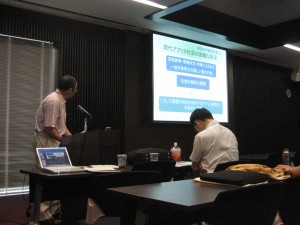
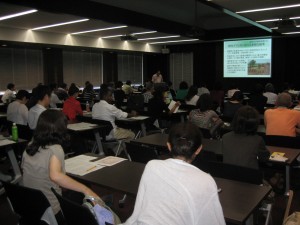
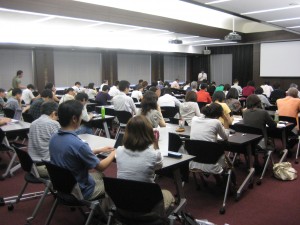
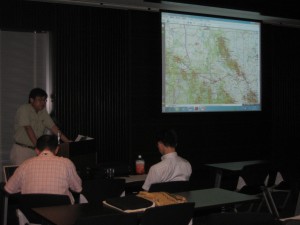
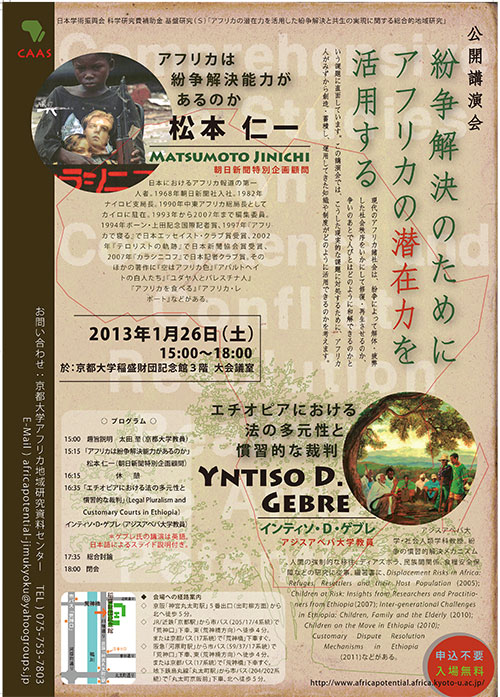
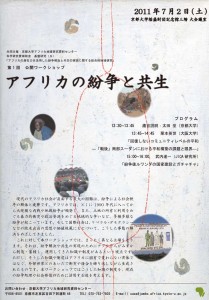
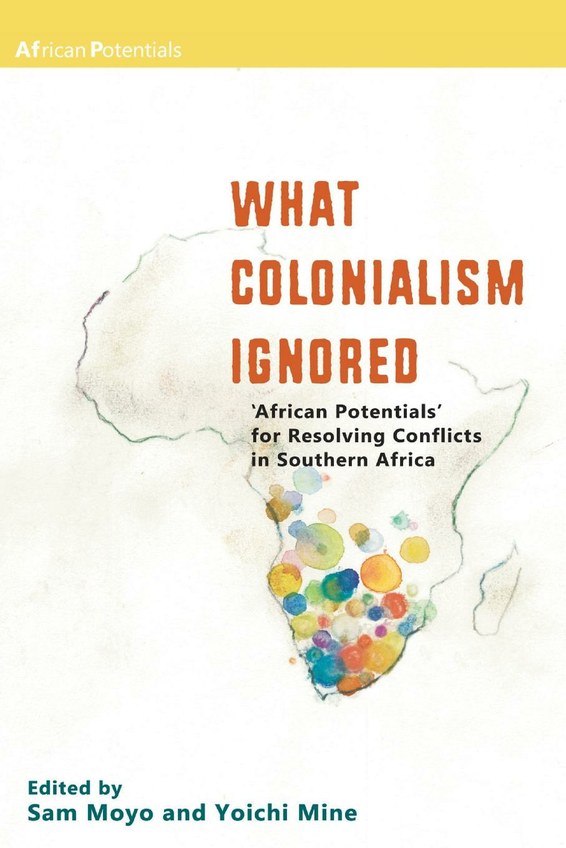
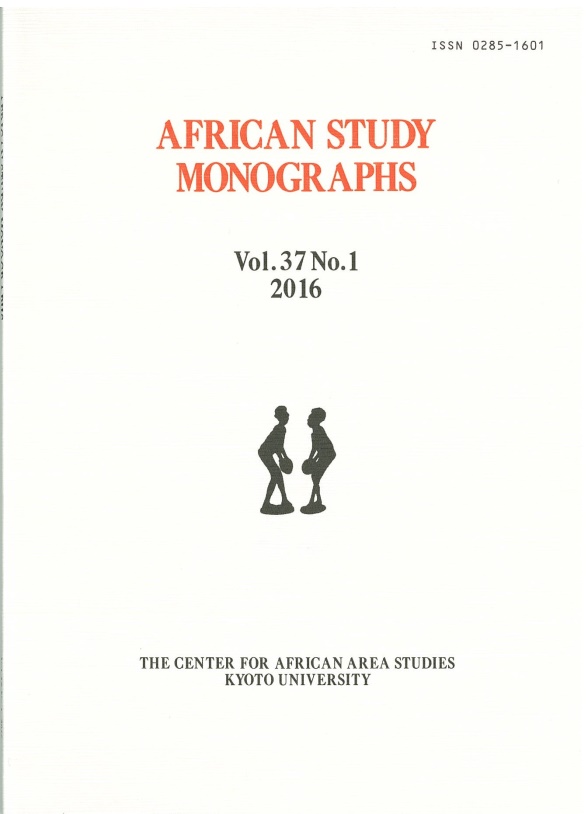
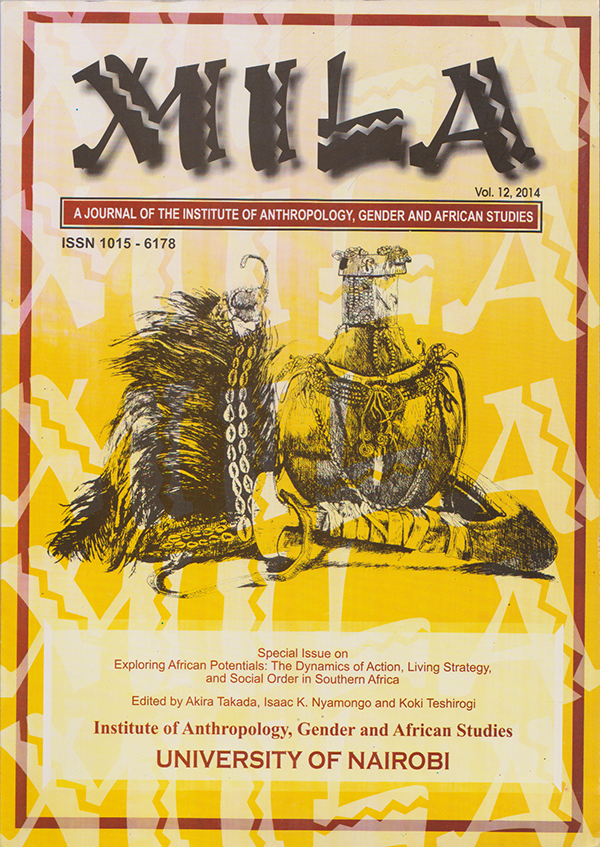 Exploring African Potentials, Mila Special Issue
Exploring African Potentials, Mila Special Issue